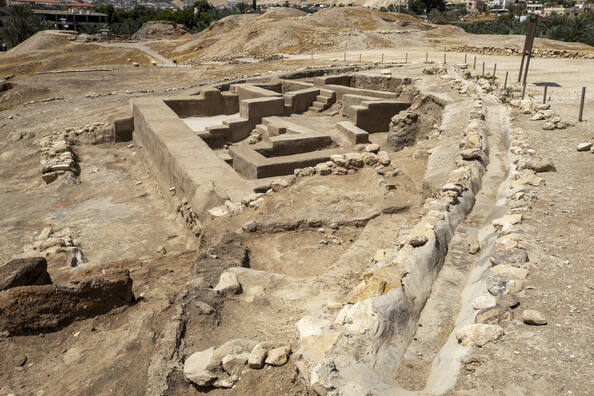古耶利哥城/苏丹台形遗址
Ancient Jericho/Tell es-Sultan
Ancient Jerico/Tell es-Sultan is located northwest of present-day Jericho in the Jordan Valley in Palestine, the property is an oval-shaped Tell, or mound, that contains the prehistorical deposits of human activity, and includes the adjacent perennial spring of ‘Ain es-Sultan. By the 9th to 8th millennium BC, Neolithic Ancient Jericho/Tell es-Sultan was already a sizeable permanent settlement, as expressed by surviving monumental architectural attributes such as a wall with a ditch and a tower. It reflects the developments of the period, which include the shifting of humanity to a sedentary communal lifestyle and the related transition to new subsistence economies, as well as changes in social organisation and the development of religious practices, testified by skulls and statues found. The Early Bronze Age archaeological material on the site provides insights into urban planning, while vestiges from the Middle Bronze Age reveal the presence of a large Canaanite city-state, equipped with an urban centre and technologically innovative rampart fortifications, occupied by a socially complex population.
Description is available under license CC-BY-SA IGO 3.0
Ancien Jéricho/Tell es-Sultan
L’Ancien Jéricho/Tell es-Sultan est situé au nord-ouest de l'actuelle Jéricho dans la vallée du Jourdain en Palestine. Le bien est un Tell, ou monticule, de forme ovale qui recèle les gisements préhistoriques d’activités humaines, et comprend la source voisine pérenne de 'Ain es-Sultan. Entre le IXe et le VIIIe millénaire avant notre ère, l’Ancien Jéricho/Tell es-Sultan néolithique était déjà un établissement permanent important, comme en témoignent les attributs architecturaux monumentaux qui ont survécu, tels qu'un mur avec un fossé et une tour. Il reflète les évolutions de cette période, notamment le passage de l'humanité à un mode de vie communautaire sédentaire et la transition connexe vers de nouvelles économies de subsistance, ainsi que des changements dans l'organisation sociale et le développement de pratiques religieuses, comme en témoignent les crânes et les statues découverts. Le matériel archéologique de l'âge du Bronze ancien sur le site donne des indications sur la planification urbaine, tandis que les vestiges de l'âge du Bronze moyen révèlent la présence d'une grande cité-État cananéenne, dotée d'un centre urbain et de fortifications à remparts technologiquement innovantes, occupée par une population socialement complexe.
Description is available under license CC-BY-SA IGO 3.0
أريحا القديمة / تل السلطان
يقع هذا العنصر في وادي الأردن وهو عبارة عن تل ذي شكل بيضوي يحتوي على بقايا أثرية تعود لنشاط بشري من حقبة ما قبل التاريخ، وتقع بالقرب منه "عين السلطان" وهي نبع ماء دائم. وقد نشأت في هذا الموقع مستوطنة دائمة بين الألفية التاسعة والألفية الثامنة قبل الميلاد نظراً إلى وجود التربة الخصبة في الواحة وسهولة الوصول إلى المياه. وتشهد الجماجم والتماثيل التي وُجدت في الموقع على وجود ممارسات طقسية لدى السكان الذين عاشوا هناك في العصر الحجري الحديث، وتشير اللقى الأثرية التي تعود إلى العصر البرونزي المبكر إلى وجود تخطيط للمدن. وتكشف آثار العصر البرونزي الأوسط عن وجود مدينة دولة كنعانية كبيرة عاش فيها سكان يتسمون بعلاقات اجتماعية معقدة.
source: UNESCO/CPE
Description is available under license CC-BY-SA IGO 3.0
古耶利哥城/苏丹台形遗址
遗产位于约旦河谷,是一包含史前人类活动遗迹的椭圆形土丘,还包括毗邻此地、常年不竭的“苏丹之泉”(Ain es-Sultan)。由于绿洲的肥沃土壤和便利水源,早在公元前9-8千年,这里就出现了人类永久定居点。在遗址上发现的头骨和雕像展示了此地新石器时代居民的宗教崇拜习俗;青铜器时代早期的考古资料显示出城市规划的迹象;青铜器时代中期的遗迹则表明这里曾有一个大型迦南城邦,居住着复合社会群体。
source: UNESCO/CPE
Description is available under license CC-BY-SA IGO 3.0
Древний Иерихон/Телль-эс-Султан
Расположенный в долине реки Иордан объект представляет собой курган овальной формы, содержащий археологические находки тысячелетней деятельности человека, и прилегающий к нему многолетний источник Айн-эс-Султан. Постоянное поселение возникло здесь к IX-VIII тысячелетию до н.э. благодаря плодородным почвам Иерихонского оазиса и легкому доступу к воде. Найденные на территории поселения черепа и статуэтки свидетельствуют о культовой практике неолитического населения, а археологические материалы раннего бронзового века имеют признаки градостроительства. Находки эпохи средней бронзы свидетельствуют о существовании крупного ханаанского города-государства, в котором проживало социально сложное население.
source: UNESCO/CPE
Description is available under license CC-BY-SA IGO 3.0
Prehistórica Jericó /Tell es-Sultan
Situado en el valle del Jordán, el sitio es un tell o montículo de forma ovalada que contiene los restos arqueológicos depositados tras milenios de actividad humana, e incluye el manantial perenne adyacente de 'Ain es-Sultan. Hacia los milenios octavo y noveno a.C. ya había surgido aquí un asentamiento permanente, debido a la fértil tierra del oasis de Jericó y al fácil acceso al agua. Los cráneos y las estatuas hallados en el yacimiento atestiguan prácticas cultuales que realizaban las poblaciones neolíticas que vivían allí, y el material arqueológico de la Edad de Bronce temprana muestra indicios de planificación urbana. Los vestigios de la Edad de Bronce media revelan la presencia de una gran ciudad-estado cananea ocupada por una población socialmente compleja.
source: UNESCO/CPE
Description is available under license CC-BY-SA IGO 3.0
